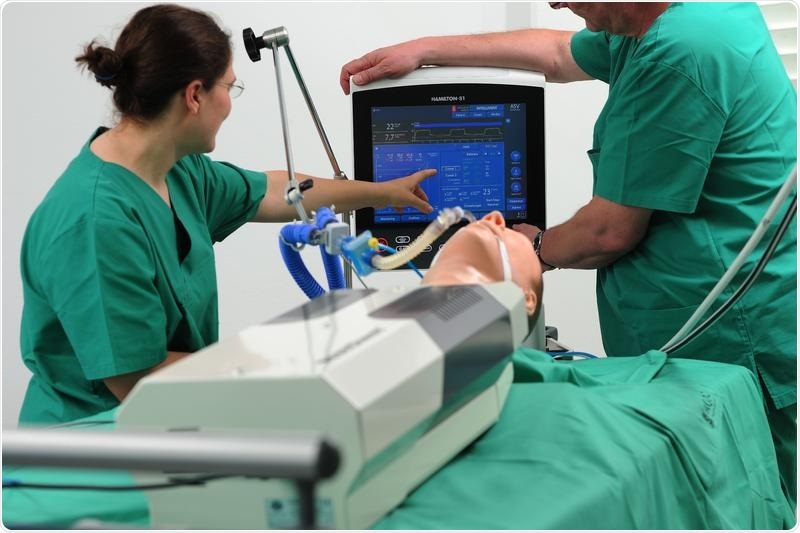COVID-19 is a disease caused by the SARS-CoV-2 virus that affects the respiratory system in humans. By using realistic lung simulators, clinicians can train how to apply respiratory support to patients affected by the virus.
Why is simulator-based training so important and why is it important to use accurate and realistic simulators when training?
The airline industry has been using simulation-based training for decades, and has become one of the safest industries in the world.
The topic of training is not flying per se, but to experience rare and dangerous flight conditions and to learn what to do in those cases. Such cases need to be highly realistic to achieve the desired training effect.
How does the TestChest achieve realistic simulation? What factors does the TestChest consider when converting a student’s actions into a lifelike response, and what vital statistics does it show?
The key is that the access points that are identical to a patient’s access points: the airways and peripheral circulation. Therapy is provided by connecting the airways to a respiratory support device and adjusting the support parameters.
The sensors inside TestChest measures the level of therapy, and the microprocessor built into TestChest calculates the response of the patient depending on the pre-set pathology.
The microprocessor also calculates the resulting oxygen saturation in the arterial blood, sending this data to an artificial finger to which a pulse oximeter of any brand can be attached.
The oxygen saturation provides a measure of the outcome of the therapy.

Image Credit: Organis GmbH
What modalities are possible when connecting the TestChest to a ventilator? How is the TestChest compatible with ventilators and parts already used?
As the TestChest can be treated like a real patient, any ventilator or respiratory device will connect to TestChest.
This includes intensive care ventilators as well as CPAP systems and anesthesia machines. The artificial finger takes any pulse oximeter on the market.
What are the benefits of this simulator compared to other simulators used for respiratory training?
Conventional simulators require an operator to adjust the outcome variables, like oxygen saturation, based on the perceived benefit of the therapy delivered by the trainee.
You can imagine that the response will not only differ from trainee to trainee but also from operator to operator.
In contrast, TestChest is fully autonomous, no operator input is needed. As a result, simulation is highly consistent.
In what applications and areas of medicine is the TestChest most beneficial?
TestChest is a dedicated lung simulator for training of respiratory therapy in intensive care medicine.
How could the TestChest revolutionize medical treatments?
Today, 100’000 patients die every year because of medical errors. In intensive care, the guidelines to ventilate patients are often not followed, although they have been shown to improve care.
It is our bias that simulation-based training is key to applying safe respiratory therapy and to avoid catastrophes in case of exceptional and dangerous situations.
How does the COVID-19 virus affect the lungs?
I am not a physician so unfortunately, I cannot comment on this. However, we have learned from clinicians at the bedside that COVID-19 patients show very unusual respiratory mechanics and gas exchange, and have implemented the observations into scenarios for TestChest.
Because TestChest is highly versatile, we could implement these unusual observations without any problem.

Image Credit: iunewind/Shutterstock.com
When and why did neosim look at applying TestChest to the COVID-19 pandemic? Why is simulator-based training applicable to COVID-19?
It was quite obvious after the first feedback from clinicians that a lung simulator would be great to train and explore new ventilation possibilities.
We got many suggestions for testing and exploring, including the use of one ventilator for several patients.
How has the TestChest been used to help with the COVID-19 pandemic so far?
TestChest was helpful as a training tool in preparation for clinical personnel to provide respiratory support as well as a test device for ventilator developers, for example at CERN, Geneva, ETH in Zürich, or CAE in Canada.
How is the TestChest being used to develop new ventilators for treating COVID-19?
Developers need to create ventilators for patients, not for physical entities. For this reason it would be great to have a patient in the lab, which obviously, is not possible.
With TestChest, the engineers can test directly on a “near” patient which certainly helps to speed up development.
Has the use of TestChest helped to improve understanding of the effect of COVID-19 on the respiratory system?
No, TestChest is a phenomenological system, i.e. it acts “as if” it would be a real patient. Lung mechanics and gas exchange are like in real patients, yet the mechanisms behind TestChest are mathematical models, not biology.
How could TestChest help to keep people prepared for the possibility of future respiratory-based virus pandemics?
Since TestChest is highly versatile, I trust that we can simulate future respiratory diseases even if we do not know them today.

Image Credit: Aqai
What do you see the future of simulator-based training to be?
ZERO preventable deaths. Simulation based training is key to patient safety. I have heard that a British Newspaper once wrote: Pilots train in simulators, doctors on patients.
With the advent of high-tech simulators, training on patients might one day be obsolete.
Where can readers find more information?
Read more about neosims lung simulators
Read about availability in the USA here
Read about availability in Asia here
About neoism AG
neosim AG is a family-owned business and was founded to create the best autonomous lung simulators. LuSi is the star product, a baby to simulate lung function.
Josef X. Brunner, PhD, started his career as a developer for a NASA ventilator for space, spent 20 years with Hamilton Medical to create their new closed-loop control ventilator fleet, and later created a couple of start-ups, all in the field of respiratory support and diagnostics.
Today, he is the CEO of neosim AG.